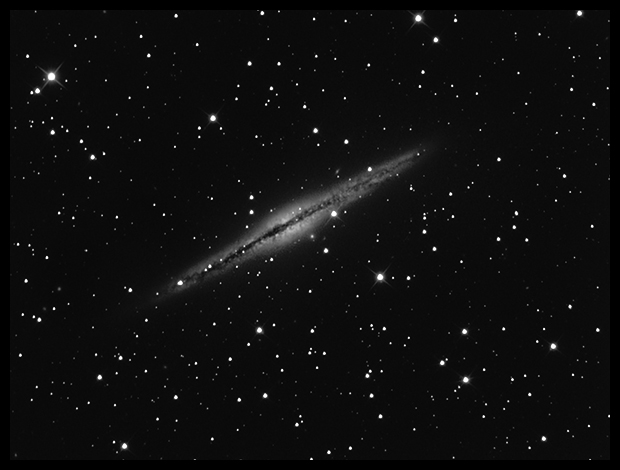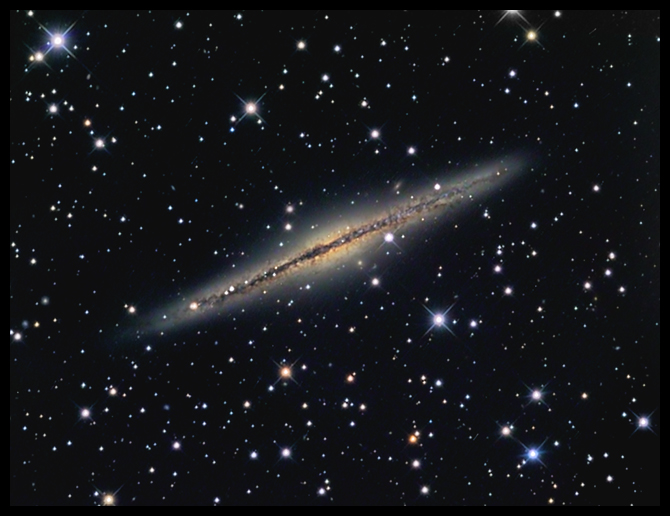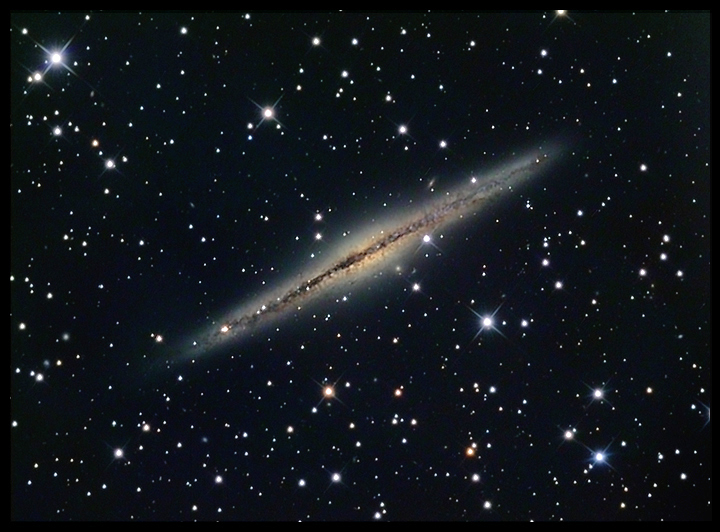11/24/2011. An unexpected opportunity to image on Thanksgiving evening coincided with exceptionally clear and exceptionally steady skies, a rare combination which the Clear Sky Clock neatly forecast. In twilight, I made fresh flats then started with a new-to-me subject: a Bok globule in Cepheus, Barnard's dark nebula 175, whose bright region is van den Bergh 152 (aka Cederblad 201). Doesn't it look just a little like a cornucopia spilling stars into the northern sky?

vdB 152 glowing within Barnard 175, a Bok Globule in Cepheus
12x900s L, 1x900s RGB
There's a lot going on here. Here's the abstract from a paper in the ApJ Letters:
John Bally and Bo Reipurth
Center for Astrophysics and Space Astronomy, Campus Box 389, University of Colorado, Boulder, CO 80309
Received 2001 January 25; accepted 2001 March 23; published 2001 April 30
ABSTRACT
The Bok globule B175, located toward a giant region of patchy extinction 10° above the Galactic plane known as the Cepheus Flare, is currently engaged in a chance encounter with a B9.5 V star, producing a prominent reflection nebula, Ced 201. Partly owing to the presence of this star, a fairly accurate distance estimate of 400 pc can be derived for B175. An imaging and spectroscopic study of B175 led to the discovery of a new Herbig-Haro (HH) object, HH 450, emerging from a deeply embedded and cold IRAS source, 22129+7000. Furthermore, we find several parsec-scale filaments of emission that trace the rim of a new supernova remnant, G110.3+11.3, which appears to be approaching the globule. This remnant is located near the edge of a large, 6° radius H I and CO cavity that coincides with a bright diffuse soft X-ray enhancement, probably due to several recent supernova explosions. At 400 pc, G110.3+11.3 is one of the closer known supernova remnants. The supernova remnant and the HH flow appear to be heading toward a frontal collision in about 1000 yr.
So. About 10:30, with over three hours of exposure already put away (I love these long nights on standard time), I slewed to NGC 891 and confirmed focus. PSFs are tight (1.6 - 1.7 arc seconds), and the guide-plot is reassuringly Appalachian (rather than Sierran) with almost exclusively sub-arcsecond corrections made once every five seconds. I left the telescope to pile up photons from the Eocene for the rest of the night.
Except... seeing may be good and corrections small, but they do add up. I saw clear signs of field rotation in the first frame, so I allowed the second to complete, then cut the sub-exposure time in half for the rest of the night. It's too good a night to screw up with avoidable trailing. I really need to dial in polar alignment soon.
NGC 891 well begun:

NGC 891 (a work in progress)
2x1800s L, 2x900s L

And since the theme for the day seems to be "things that look like what they are not," doesn't that look an awful lot like the Bellerophon? (No! My mistake! It looks like deep space cruiser C–57D, the starship commanded by Leslie Nielsen. The Bellerophon was the ship that delivered the doomed colonists to Altair 4 in the first place. We never see that ship.)
Good morning! It was an unusual night, meteorologically: 27°F down here but 50°F at the top of Beech Mountain. The maps associated with the Clear Sky Clock made it plain that there were two best places for stargazing in North America last night: the southern California deserts and here. Only here and there were transparency, absence of clouds, and seeing all near the top of the chart. Here's last night's data combined with previous NGC 891 data, all piled up together and calibrated using the best available flats and darks:

NGC 891, November's data
35x900s, 20x1800s L
1x900s RGB
(total exposure 19h30m)
The "Cepheus Flare" mentioned in the ApJ Letters above is an extension of gas and dust out of the plane of the Milky Way (the Bok globule shown is a tiny part of the extensive Cepheus Flare). Is the flare similar to the extensions above and below the galactic plane of NGC 891 which are visible in this photo? Or is it a larger-scale or unrelated phenomenon?
11/25/2011. Another portion of the Cepheus Flare has my attention tonight: that area the APOD folk run at Halloween, vdB 141 and environs, where two Bok globules are connected by a sea of dust, where oddly perfect Casper-esque ghost shapes rise up from the fog, where one globule is collapsing into a binary star and the polar jet cuts through the clouds. The definitive image is by Adam Block using 3.2x my aperture, from a dark, mountain-top site, with a CCD roughly twice as efficient as mine with acres more collecting area. Adam's killer image includes something like 9 hours of luminance and 4 hours in each channel of RGB, that with a 32-inch telescope on Mount Lemmon feeding a high-end CCD. Tonight I took 3 hours of luminance and 15 minutes of RGB. Put it like that and it's a miracle you can see anything at all! I collected on the order of 2% of Adam's signal. And, to add insult to futility, my flats aren't working very well tonight. Anyway, here:

vdB141 & friends
12x900s L, 1x900s RGB
This field would be better framed with the long side of the chip running E/W rather than N/S, but I didn't want to move anything prior to finishing my November fetish with NGC 891. The tall "ghost" is cut off at the left edge; the short one is just inside the frame. The deep red glow on the far right is part of the bipolar outflow from a newborn binary star presumably buried deep in the Bok globule from which the beam emerges. That I can catch that at all with such a casual attempt bodes well for future all-out efforts.
I tried reshooting my flats after the 12th frame. This time I used the electroluminescent flatfield panel I put together for the A-P refractor. I combined it with the 2-stage diffuser I normally use with the Ritchey. Two tenths of a second makes a decently illuminated flat. It seems to have worked at least as well as the 2-stage diffuser by itself. No, the undersized illuminator produces complex renderings of dust donuts which result in both bright and dark artifacts when used as a flat. Don't do this. Tonight's flats look good but they are ineffective in controlling dust donuts and other defects of illumination. I'm doing the best I can by manually removing those artifacts, but the result is crude and harsh. Found! When combining flats, don't get fancy. Average them. Just average them. No sigma clips etc. The electroluminescent panel does not work well, as noted, but diffused sky flats from last evening work very well when properly combined.
With 50x the signal and plenty of expertise, Adam's photo is as smooth and subtle as mine is not. Anyway, it's a sure thing that the ghosts and stellar winds near vdB141 are within reach. I just need more exposure, as usual.
Cepheus gets too low to keep shooting by 10:30, which is just when NGC 891 approaches the meridian and moves clear of bird feeder tree. I slewed there, refined focus (1.7" FWHM), and added one more night's data, 5 hours under steady, reasonably transparent skies. With this addition, the pile has reached a milestone. It's my first day-long exposure:

NGC 891
Total exposure: one day
(24h30m)
Except where noted, deep-sky photos are made with an SBIG ST2000XM CCD behind a 10-inch Astro-Tech Ritchey-Chretien carried on an Astro-Physics Mach1GTO. The CCD is equipped with Baader LRGB and 7nm H-a filters. A Meade DSI Pro monochrome camera looking through a modified Orion off-axis guider keeps the OTA pointed in the right direction. The imaging camera is controlled via Nebulosity 2; the guide camera is operated by PHD Guide 1.13, both by Stark Labs. The stock focuser on the AT10RC has been augmented with Robofocus 3.0.9 using adapters turned on the lathe downstairs. Maxim DL5.12 performs image calibration, alignment, and stacking; Photoshop CS4 and FocusMagic 3.0.2 take it from there. Gradient Xterminator by Russell Croman and Astronomy Tools by Noel Carboni see their share of work, too.
:: top ::